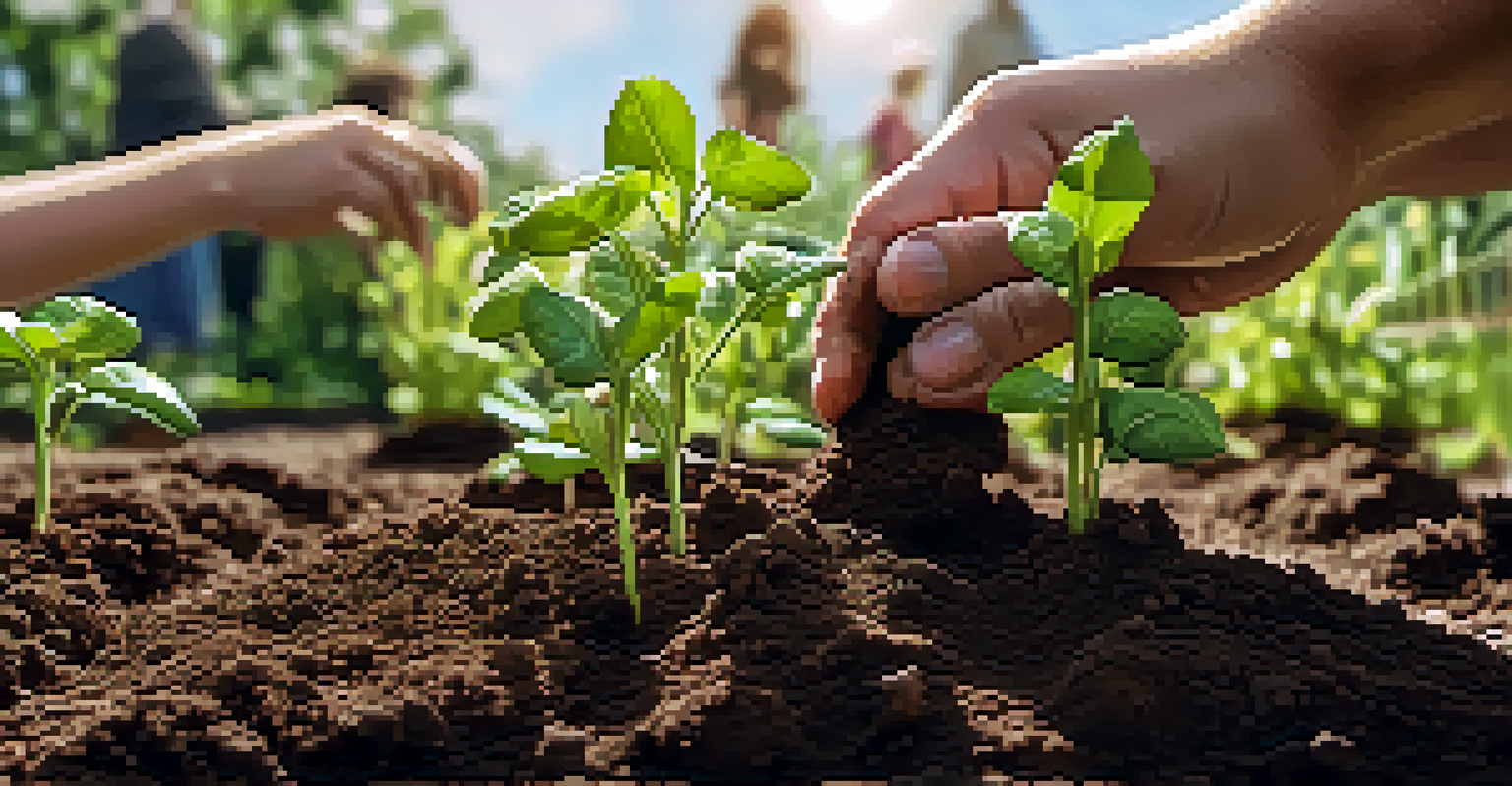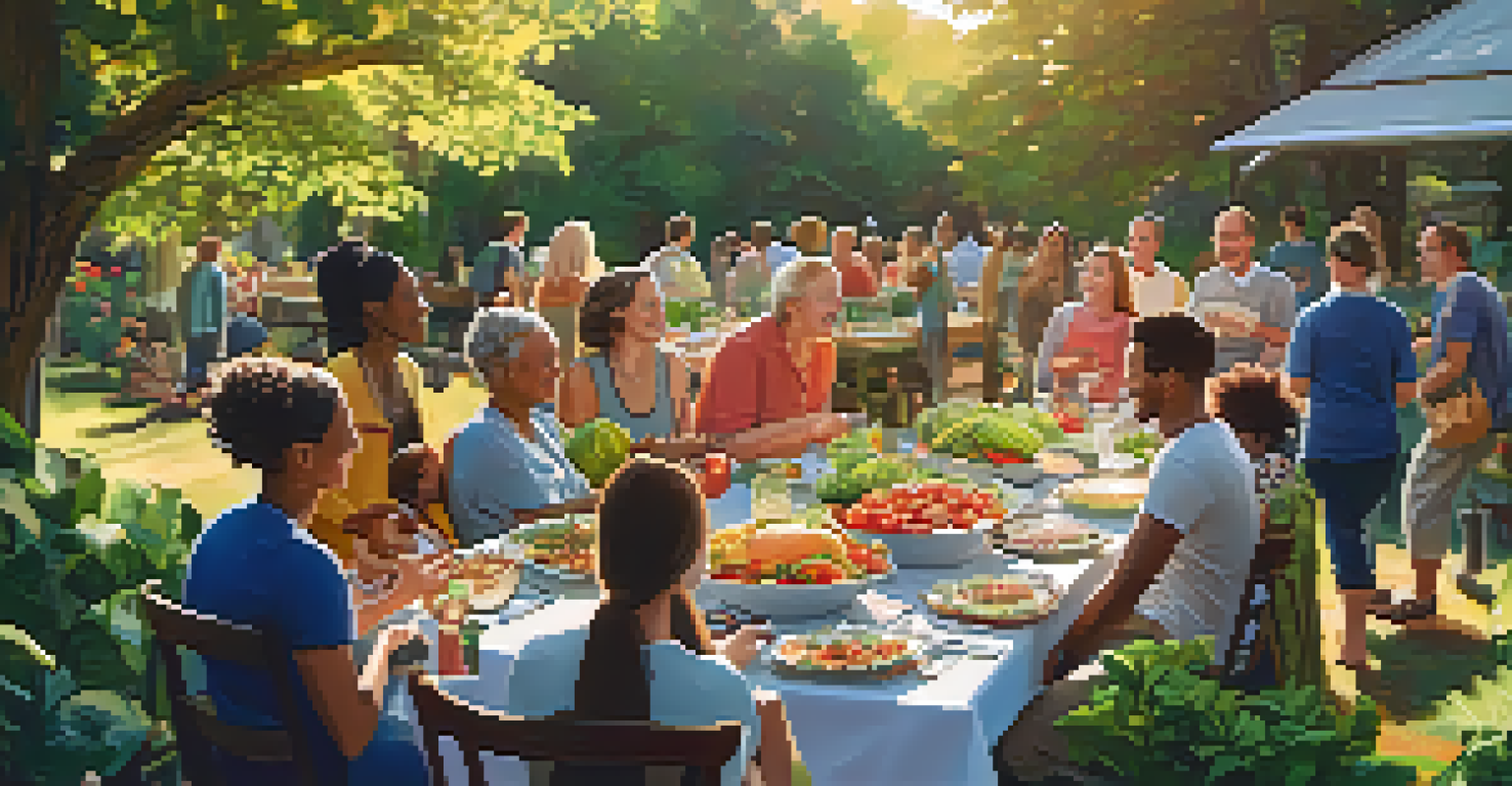How Community Gardens Are Fostering Wellness in California

The Rise of Community Gardens in California
In recent years, California has seen a surge in community gardens, transforming vacant lots into vibrant green spaces. These gardens are not just patches of soil; they are hubs of community engagement and collaboration. As urban areas grow, the need for accessible green spaces becomes increasingly essential for residents' well-being.
To plant a garden is to believe in tomorrow.
The rise of these gardens reflects a broader trend towards sustainable living and local food production. Many communities are recognizing that growing their own fruits and vegetables not only fosters a connection to nature but also promotes healthier eating habits. With California's diverse climates, community gardens can flourish year-round, providing fresh produce to local neighborhoods.
Moreover, these gardens serve as a response to food deserts—areas with limited access to affordable and nutritious food. By establishing community gardens, residents can combat food insecurity while also cultivating a sense of pride in their neighborhood. This grassroots movement has truly become a lifeline for many.
Promoting Physical Health through Gardening
Gardening is a fantastic way to boost physical health, and community gardens provide the perfect setting for this activity. Engaging in gardening tasks like digging, planting, and weeding offers a full-body workout, which can improve cardiovascular health and strengthen muscles. Plus, spending time outdoors in the sunshine is an excellent source of Vitamin D, essential for overall health.

In addition to physical benefits, gardening can also enhance mental well-being. The act of nurturing plants can be therapeutic, reducing stress and anxiety levels. Many gardeners report feelings of joy and satisfaction from watching their plants grow, creating a positive feedback loop that encourages continued participation.
Community Gardens Boost Well-Being
Community gardens enhance physical and mental health by providing spaces for exercise, social interaction, and a connection to nature.
Community gardens also encourage social interaction, which can further promote physical activity. Residents often come together for group gardening days, which not only gets them moving but also fosters friendships and a sense of belonging. This blend of physical and social activity is key to a healthier lifestyle.
Mental Health Benefits of Community Gardens
The mental health benefits of community gardens are profound and multifaceted. Engaging with nature has been shown to reduce symptoms of depression and anxiety, providing a calming effect that many urban dwellers desperately need. The simple act of tending to plants can offer a meditative experience, allowing individuals to recharge their spirits.
The best time to plant a tree was twenty years ago. The second best time is now.
Furthermore, community gardens create a space for connection and support. Gardeners often share their experiences and challenges, creating an environment of mutual encouragement and understanding. This sense of community can combat feelings of isolation, particularly for those who may be new to an area or facing personal difficulties.
Additionally, the act of growing food can instill a sense of purpose and accomplishment. Seeing the fruits of one's labor can boost self-esteem and foster a positive outlook on life. In this way, community gardens not only nourish the body but also uplift the mind.
Strengthening Community Connections
Community gardens do more than just grow food; they cultivate connections between residents. These spaces bring people together from diverse backgrounds, encouraging collaboration and understanding. Working side by side in the soil can break down barriers and foster friendships that might not have formed otherwise.
Events hosted at community gardens, such as potlucks, workshops, and educational programs, further strengthen these bonds. Residents can share their gardening skills, recipes, and cultural traditions, creating a rich tapestry of shared experiences. These interactions build trust and a sense of belonging, essential components of a healthy community.
Strengthening Community Bonds
These gardens foster connections among residents, encouraging collaboration and cultural exchange through shared gardening experiences.
Moreover, these gardens often serve as a platform for local activism and environmental stewardship. Community members can advocate for sustainable practices and policies, working together towards a common goal. This collective action not only improves the neighborhood but also empowers residents to take charge of their community's future.
Educational Opportunities in Community Gardens
Community gardens are fantastic educational resources, particularly for children and youth. Many schools partner with local gardens to provide hands-on learning experiences that teach students about nutrition, biology, and environmental science. These lessons extend far beyond the classroom, instilling a lifelong appreciation for nature and healthy eating.
Workshops and classes offered at community gardens also provide adults with valuable skills. From organic gardening techniques to cooking demonstrations, these educational opportunities foster a culture of learning and personal growth. Participants often leave with new knowledge and confidence, which they can share with their families and neighbors.
In this way, community gardens become centers of knowledge and skill-building. They help create informed citizens who understand the importance of sustainable practices and local food systems. This ripple effect can lead to healthier lifestyles and stronger communities.
Environmental Impact of Community Gardens
Community gardens play a crucial role in enhancing urban environments and promoting biodiversity. These green spaces contribute to improved air quality, reducing pollution and creating cleaner cities. They also provide habitats for various pollinators and wildlife, helping to maintain ecological balance.
Moreover, community gardens can help mitigate the urban heat island effect. By increasing vegetation in densely populated areas, they create cooler microclimates that benefit both people and plants. This cooling effect can have significant implications for energy use, reducing the need for air conditioning and lowering overall energy costs.
Educational Resources for All Ages
Community gardens serve as valuable educational hubs, teaching both children and adults about nutrition, sustainability, and gardening skills.
Additionally, community gardens encourage sustainable practices such as composting and rainwater harvesting. These practices not only enrich the soil but also promote responsible water use. As community members learn and adopt these eco-friendly strategies, they contribute to a healthier planet for future generations.
The Future of Community Gardens in California
Looking ahead, the future of community gardens in California appears promising. As more residents recognize the benefits of these green spaces, we can expect to see an increase in their establishment across the state. City planners and local governments are also beginning to support these initiatives, recognizing their value in promoting community health.
Innovations in gardening technology and practices will likely emerge, making it easier for even the most novice gardeners to participate. Vertical gardens, hydroponics, and permaculture techniques may become more common, allowing communities to maximize their gardening potential in limited spaces. This evolution will make community gardening accessible to even more people.

Ultimately, the continued growth of community gardens in California represents a movement towards healthier, more connected communities. By investing in these green spaces, residents are not only improving their own well-being but also fostering a brighter future for their neighborhoods and the planet.